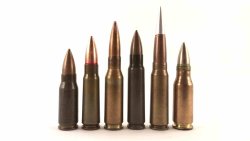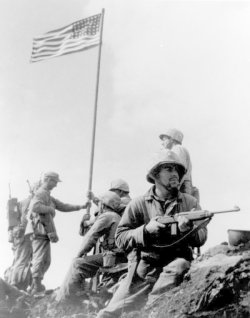In Part 1 we saw how during the 1920s and 1930s several countries attempted to develop their own versions of intermediate power cartridges and automatic weapons to fire them, but none was ever adopted.
And here’s the big question: if the concept was known and found worth researching as early as 1918, why it was not fielded until 1942? There’s no simple answer, but we can speculate to provide some rationale, as follows:
- the military, especially the top ranking military personnel, is by nature quite conservative. And the very concept of arming every infantryman with a rifle capable of firing a full combat load of 100 rounds in about a minute or two was alien to many commanders who grew up during the era of bolt action rifles with magazine cut-offs.
- despite weight and cost savings “round per round” offered by intermediate cartridges compared with standard rifle rounds, greatly increased expenditure of smaller rounds in full-automatic weapons would still put additional strain on manufacturing and logistic capabilities, not to mention budgets, which were drastically cut back after the end of WW1.
- after WW1 machine guns were considered to be essential infantry arms, and using reducing power ammunition in machine guns was out of the question at the time. Therefore, this would require keeping two different rounds in the supply chain for all infantry units, making logistics even more complicated.
- up until the mid- or late 1930s typical targets for infantry rifle fire included, besides enemy personnel, other battlefield objects such as horses (cavalry was still considered important by many nations), armored cars, and low-flying combat aircraft. All of those targets are tougher than an average human being, and using reduced power ammunition against these types of targets would place troops at an obvious disadvantage
Introducing the 7.92 Kurz and the Maschinenkarabiner
Overall, it appears that most armies of the interwar period considered the “full power” semi-automatic rifle as a next logical step in the evolution of the individual infantry weapons. Some nations tried to create automatic rifles (such as the Soviets with their unsuccessful Simonov AVS-36), but the majority was set on the self-loading only types. One notable attempt to reduce the power of the standard infantry rifle was made by the Americans during the late 1920s - early 1930s, when they tried to replace the old and powerful .30-06 (7.62x63) cartridge with a .276 Pedersen (7x51) cartridge, developed specifically for new semi-automatic military rifles. This attempt was cancelled, though, mostly on financial and logistic grounds.
Despite all these reasons not to adopt reduced power automatic rifles, military experts and industry engineers kept working on the new concept. Among these were the Germans, who took the intermediate cartridge route in 1935. By 1940 the Department of Armaments, German Army (Heereswaffenamt, or HWaA in short), had settled on the 7.92x33 intermediate power rifle cartridge, developed by the Polte company. From the performance point of view, the nominal caliber of 7.9mm was inferior to the originally proposed 7mm caliber, but 7.9mm was chosen for its manufacturing benefits, as new barrels, cases and bullets could be made on existing machinery, originally used to produce barrels and ammunition for standard infantry 7.92x57 Mauser cartridge.

The 7.92x33 round, also known as the 7.92 Kurz (short), fired an 8 gram bullet at about 690 m/s, with a muzzle energy of about 1900 Joules. Compared with the 7.92x57 Mauser with a standard s.S. bullet (12.8 gram at 800 m/s, 4100+ Joules), this new “Kurz” cartridge generated about 50% less recoil and also weighed about 40% less (16.7 g as compared to 26.9 g). Once this promising new round was selected, contracts were issued to the Haenel and Walther companies to develop a new class of automatic weapons – so called “machine carbines”, or Maschinenkarabiner in German (MKb in short).
By 1942, two versions of the German MKb.42 machine carbines, the MKb.42(H) by Haenel and the MKb.42(W) by Walther, were tested by Wehrmacht on the Russian front, and the concept was found to have its merits. However, official adoption was delayed by troops requesting some changes (including conversion to fire from a closed bolt as opposed to the original “submachine gun style” open bolt firing), and, more important, by personal orders from Adolf Hitler to cease all development of new classes of small arms. To circumvent Hitler’s orders, the next version of the Machinenkarabiner was renamed to Maschinenpistole (submachine gun, a class of weapons already in widespread service with German army), and entered production in 1943 as the MP-43. Once reports of the MP-43 success at the front reached German Headquarters in 1944, Hitler finally approved mass production of the new weapon and its associated 7.92mm Kurz cartridge, personally christening it “Das Sturmgewehr 44” (Stg.44 in short), which means “Storm” or “Assault” rifle. It was pure propaganda, as at the time Hitler’s’ Germany was all about defense instead of the earlier “Sturm und Drang” attitude. Overall, about 425,000 Sturmgewehr rifles were made for the Wehrmacht before the war ended, and it made a sufficient impression on allied forces to warrant very close examination.

The American Way

At the same time (1939-40) the American army issued a request for the development of a “lightweight rifle”, a handy .30 caliber (7.62mm) automatic carbine, with the intention of using it as a more effective replacement for the military pistol. The cartridge developed for this weapon by the Winchester Company, was based on the .32WSL hunting round, and fired a 7 gram bullet at a muzzle velocity of about 600 m/s (muzzle energy 1,300 Joules). Loaded with a round-nosed bullet, it looked more like stretched pistol round than a downscaled rifle round, but it was about twice as powerful as most contemporary military pistol rounds. Shortly after the start of trials the US Army dropped the “full auto” requirement, and the actual M1 carbine, adopted in 1941, was a semi-automatic only weapon. Despite its original concept of “Personal Defense Weapon” being exactly opposite to that of “Assault rifle”, the M1 carbine quickly became popular among fighting troops for its handiness and rapidity of fire. By 1944, it became apparent that a full-automatic version of the M1 would make sense for front-line troops, and the selective-fire M2 carbine was approved for service and put into production toward the end of the war.
By modern ballistic standards, it may fall short of being a “true assault rifle”, but, nonetheless, it was an important historical weapon which deserves honorable mention at the very least.
To be continued...










